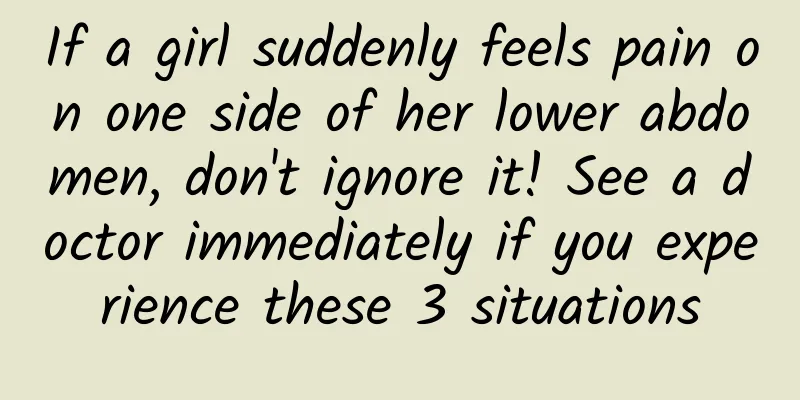If a girl suddenly feels pain on one side of her lower abdomen, don't ignore it! See a doctor immediately if you experience these 3 situations

|
Have you ever had this experience: one day between two menstrual periods, one side of the lower abdomen suddenly felt bloated and uncomfortable for no reason, and there might also be backache, back pain, or even a little bleeding. When you felt the pain for a day and worried that you might be sick, the next day you felt better as if nothing had happened. If you have this problem, don't worry too much, it may be ovulation pain . However, if the pain is severe, the pain time is off, or there are other accompanying symptoms, do not ignore it and seek medical attention in time. What is ovulation pain? As the name implies, ovulation pain is the pain caused by ovulation. We have all learned about ovulation in biology class, and we know that the combination of sperm and egg is the origin of individual development, but do you know what the specific process of ovulation is like? There are often large and small bumps on the surface of normal ovaries, which are follicles at various stages of development. There is a theca outside the follicle, and inside there is a follicular cavity filled with follicular fluid, and a large number of granulosa cells are distributed. When the follicle matures, the follicular fluid will also become very full, and the tension of the follicular cavity will increase accordingly, and eventually burst on the surface of the ovary, "spraying" the follicular fluid and egg cells together. Copyright images in the gallery. Reprinting and using them may lead to copyright disputes. During this process, the enlarged follicles squeeze the ovaries, causing a distending pain. When the follicles rupture, they damage the surface of the ovaries, causing sharp or pulling pain. Ovulation is sometimes accompanied by a small amount of bleeding. The stimulation of the peritoneum by the follicular fluid and blood can cause dull pain and a feeling of heaviness in the lower abdomen that cannot be clearly located. These conditions together contribute to the formation of "ovulation pain". What are the characteristics of ovulation pain? Usually only one egg is released in each menstrual cycle, usually alternately by both ovaries. Therefore, the distending pain, sharp pain, pulling pain, etc. associated with follicle enlargement and rupture are often limited to one side. That is to say, if you have pulling pain in the right lower abdomen during ovulation, it means that the right ovary is ovulating this time, and of course it may be on the left side next time. However, the ovaries do not always divide the work equally, so it is possible that the pain is on the same side for several consecutive months. This is different from the dull pain, dull pain, and heavy pain related to blood stimulation, which have no fixed location. Ovulation pain may last only a few minutes to a few hours, or it may last a day or two, but generally no longer. Copyright images in the gallery. Reprinting and using them may lead to copyright disputes. After ovulation, the remaining part of the follicle will transform into the corpus luteum. The estrogen and progesterone secreted by the corpus luteum can promote the further growth and development of the endometrium, making it suitable for embryo implantation. If no fertilized egg is formed, the corpus luteum will lose its function 14 days after ovulation, and the endometrium will also shrink and slough due to the loss of hormonal support from the corpus luteum, and become menstrual discharge from the body. Therefore, ovulation pain must occur 14 days before the next menstrual period. In addition to abdominal pain, ovulation pain is sometimes accompanied by backache and lower back pain. If the pain is severe, you may also feel nauseous and have a decreased appetite. After ovulation, estrogen levels will drop to a certain extent, sometimes causing a small amount of spotting in the endometrium. How to deal with ovulation pain? Ovulation pain is a normal physiological phenomenon, generally harmless and does not require special treatment. However, ovulation pain can sometimes be particularly obvious. After diagnosis, you can take oral analgesics to relieve the discomfort. If you are troubled by ovulation pain for a long time, you can also consider using hormonal contraceptives (such as oral short-acting contraceptives, subcutaneous implants, intrauterine devices containing progesterone, etc.) to suppress ovulation. It should be emphasized that whether you ignore ovulation pain or take active measures, the prerequisite is to determine that the cause of the pain is ovulation pain. If you are not sure, you need to seek help from a professional for evaluation. If these 3 situations occur , please seek medical attention immediately! If the pain occurs 14 days before the next menstrual period, the pain level is tolerable, there are no other discomfort symptoms, and it can be relieved on its own within two days without taking any measures, then it can be preliminarily diagnosed as ovulation pain. However, ovulation pain can sometimes be particularly obvious. After diagnosis, you can take oral analgesics to relieve the discomfort. If you are troubled by ovulation pain for a long time, you can also consider using hormonal contraceptives (such as oral short-acting contraceptives, long-acting contraceptives, subcutaneous implants, etc.) to suppress ovulation under the doctor's advice. If you experience any of the following, you need to seek medical attention immediately: 1. Severe pain Regardless of whether it is ovulation pain or not, you need to see a doctor as soon as possible when the pain is severe, and you cannot take medicine on your own. Because severe pain may be caused by accidental severe ovulation pain, or it may be caused by diseases such as ectopic pregnancy, acute pelvic inflammation, appendicitis, ovarian cyst rupture, pedicle torsion, etc., but it just happened to occur at that time. So even if the pain occurs during ovulation, you should not take it lightly. If it is serious, you should go to the hospital in time. 2. Time deviation If the abdominal pain does not occur during the ovulation period (no menstruation after 14 days), or the abdominal pain lasts for more than 2 days, you should also be alert to other diseases that cause abdominal pain. If the symptoms cannot be relieved on their own, it is best to go to the hospital for a check-up. 3. With accompanying symptoms In addition to the common symptoms mentioned above, if there are other symptoms such as fever, vomiting, diarrhea, anal distension, or the bleeding pattern is not dark spotting but bright heavy bleeding, it indicates that there is a high possibility of other diseases and needs to be taken seriously and treated promptly. Planning and production Author: Doctor Feidao Duanyu Reviewer: Lan Yibing, deputy chief physician, Department of Obstetrics and Gynecology, Zhejiang University School of Medicine Planning丨Fu Sijia Editor: Fu Sijia Proofread by Xu Lailinlin |
<<: Dopamine VS endorphins, which one brings true happiness?
>>: Hey! You "sons of the earth" in armor and helmets, you have good news again
Recommend
World Water Day: Here’s what you need to know about groundwater
There is a kind of water, deep underground It is ...
The six easiest programming languages to learn for beginners
【51CTO.com Quick Translation】Learning programming...
From The Mandalorian to iQiyi’s The Bad Well, virtual production is integrated into the film and television industry
Recently, many LED manufacturers have announced t...
Big news, Mitchell is diagnosed with COVID-19! Mitchell tested positive for the new coronavirus!
On March 12, Beijing time, according to US media ...
The "little apple" from 400 million years ago was fixed to the seabed like an anchor!
From the middle Ordovician to the late Devonian, ...
The Milky Way has a mysterious sister? It can be seen with the naked eye!
Author | Feng Ziyang Review | Dong Chenhui Editor...
Let’s talk about how to operate personal content on the live streaming APP Xiaokaxiu?
How can one operate a product like Xiaokaxiu on h...
Is abnormal animal behavior a sign of an approaching earthquake?
There is no solid scientific evidence for this cl...
My first experience with advertising embedded in the body of a public account. What is the promotion effect?
Some time ago, my official account was fortunate ...
What kind of promotional materials are the most eye-catching in information flow ads?
Different types of APPs, from native advertising,...
Resolution, frame rate, HDR, color reproduction, how to choose? Hisense Hard Pro monitor: I want them all
I believe everyone is familiar with the Hisense b...
Fission Methodology: How to achieve precise fission and improve paid conversions?
Last week, I helped a friend implement a project....
Sony: There are a large number of "defectors" among PS4 players
Sony's PS4 game console has sold more than 7 m...
How much does it cost to develop the Wuhu movie mini program? Wuhu movie applet development price inquiry
More and more businesses are paying attention to ...
A piece of sugar cane was eaten and sent to the ICU! Don't eat this kind of sugar cane, it can cause death
In winter, bundles of sugar cane are often seen i...









![C4D product performance first issue [HD quality with material]](/upload/images/67cc13dabf27f.webp)